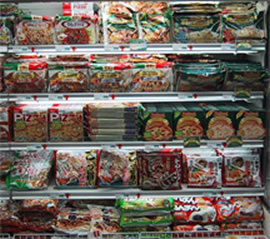Learn About Japan > Work and Workplaces in Japan > Agriculture > Food Self-Sufficiency in Japan

|

Agriculture
- Land Reform in Postwar Japan
- Why Japan's Land Reform Succeeded
- Wet Rice Agriculture
- Transplanting Rice Seedlings
- Early Mechanization of Agriculture
- Reorganization of Farm Land
- Innovations in Fruit and Vegetable Farming
- Rice Rationing and Subsidies
- Japan’s Shrinking Farm Population
- Farm Household Size and the Problem of Succession
- Who Farms in Japanese Farm Households?
- San-Chan Nōgyō
- The Changing Japanese Diet
- Dairy Farming in Japan
- What Dairy Products Do Japanese Eat?
- Beef Cattle in Japan
- The Changing Income of Farm Households
- Raising Silkworms in Japan
- Food Self-Sufficiency in Japan
- Food Self-Sufficiency in Rice
- Organic Farming in Japan
|

Japanese supermarkets today are stocked with all kinds of packaged foods from all over the world.
Photo Courtesy of Government of Alberta Website.
Food Self-Sufficiency in Japan
Food self-sufficiency means that a country produces enough food to feed all of its people without having to import food from other countries. Japan was self-sufficient in rice before the war, in part because of it colonies, but by the end of the war food was in short supply and Japan was not producing enough to feed its population. After the economy had recovered during the 1950s and boomed in the 1960s, Japan achieved self-sufficiency in overall food production in the 1970s. At the same time, the changing diet led to increased imports of some food products that were now in greater demand.
By the mid-1980s, Japan abandoned the goal of food self-sufficiency. Other countries could produce these goods more cheaply, and Japan could import them at less cost than it could produce them. Since the 1980s the overall trend has been toward decreasing food self-sufficiency.
Click on CHARTS, below, to see how self-sufficient Japan is in various foods.
|
Special Terms:
self-sufficiency
|
| Download Podcast in
English
| Japanese
|
|
Document |
Audio-Video |
Chart |
Picture |
Map
|
|

